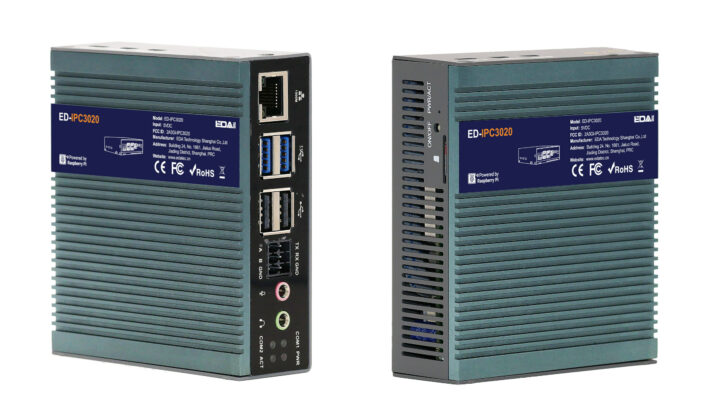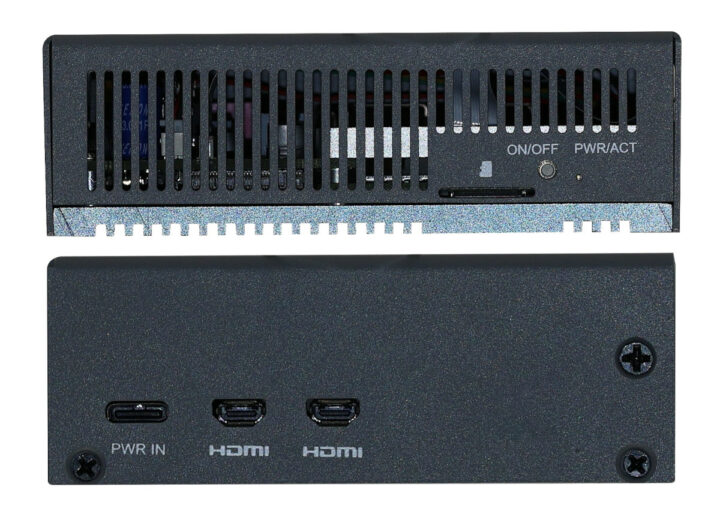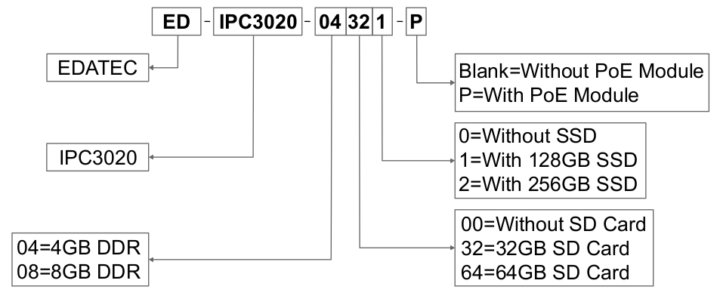EDATEC ED-IPC3020 is a fanless industrial computer based on the Raspberry Pi 5 SBC with support for an M.2 NVMe SSD up to 2260 in size, RS232 and RS485 serial ports, and stereo audio input and output jacks.
The Raspberry Pi 5 single board computer could already support an M.2 NVMe SSD thanks to add-on boards such as the PineBerry Pi HatDrive and Pimoroni NVMe Base, but with the ED-IPC3020 we have a complete Raspberry Pi 5-powered computer with M.2 NVMe storage.
EDATEC ED-IPC3020 specifications:
- SBC – Raspberry Pi 5 Model B
- SoC – Broadcom BCM2712 quad-core Arm Cortex-A76 processor clocked up to 2.4 GHz, VideoCore VI GPU, 4Kp60 H.265 decoder
- Memory – 4GB and 8GB LPDDR4X-4267 SDRAM are optional
- Storage – MicroSD card slot for the OS
- Video Output – 2x micro HDMI ports up to 4Kp60
- Networking
- Gigabit Ethernet RJ45 port with optional PoE support
- Dual-band 802.11ac Wi-Fi 5 and Bluetooth 5.0 Classic and BLE
- USB
- 2x USB 2.0 Type-A ports (up to 480Mbps)
- 2x USB 3.0 Type-A ports (up to 5Gbps)
- Misc – Power button
- Power Supply – 5V DC/5A via USB-C port
- Storage – M.2 Key-M PCIe socket for 2230, 2242, or 2260 NVMe SSD. It can also be used to boot the OS
- Audio
- 3.5mm stereo audio output jack (green)
- 3.5 mm stereo audio LINE IN jack (red)
- Serial
- RS485 via 3-pole Phoenix terminal with 120Ω terminal resistor.
- RS232 via 3-pole Phoenix terminal
- Expansion I/Os (internal only, and not useable with the ED-IPC3020 enclosure, but they might be used in a future HMI display from the company)
- 3-pin 5V/1A DC OUT 2.0mm pitch WTB connector for extended LCD
- 4-pin speaker 1.5mm pitch WTB connector with dual channel stereo audio output
- 2x MIPI CSI/DSI connectors (on Raspberry Pi 5) used for extended LCD screen, supporting I2C touchscreen and backlight adjustment
- Misc
- Power LED, ACT LED, 2x green UART LEDs (COM1 and COM2)
- RTC with SuperCAP and CR1220 battery backup
- Buzzer for an alarm function in case of bad configuration
- Power Supply – 5V DC via USB-C port on Raspberry Pi 5
- Power Consumption – 25 Watts (Max)
- Dimensions – 102.8 x 89.5 x 32.5mm
- Weight – 300 grams
- Temperature Range – Operating: -25°C ~ 60°C; storage: -25°C ~ 60°C
- Humidity – 5% ~ 95% (non-condensing)
- Certifications
- FCC 47 CFR Part 15 Subpart B
- EN IEC 62368-1/EN IEC 62311/EN IEC 61000-3-2/EN IEC 61000-3-3
- EN 55032/EN 55035/
- EN 301 489-1/EN 301 489-3/EN 301 489-17/EN 301 489-52
- EN 301 328/EN 301 440/EN 301 511/EN 301 908-1/EN 301 908-2
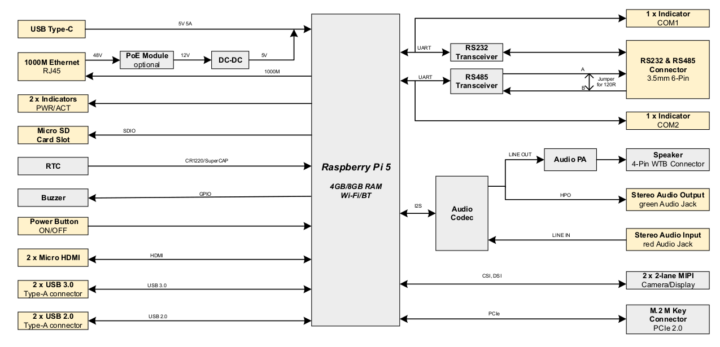
The fanless industrial computer features the Raspberry Pi 5 on one side to access most of its ports and an add-on board for the M.2 NVMe socket, serial ports, RTC battery, and buzzer, as well as speaker and 5V output connectors that will likely be used in a future Raspberry Pi 5 smart display in combination with the MIPI DSI connector on the Raspberry Pi board.
EDATEC says the ED-IPC3020 supports all four variants of Raspberry Pi OS (32-bit or 64-bit, Desktop or Lite) and they likely also provide a script to install any drivers and configuration files required for the additional features. The company sent us a photo of the internal design where we see a large thermal pad used for cooling on the bottom side of the Pi 5 and the M.2 SSD on the add-on board connected to the 40-pin GPIO header and the PCIe connector in some ways.
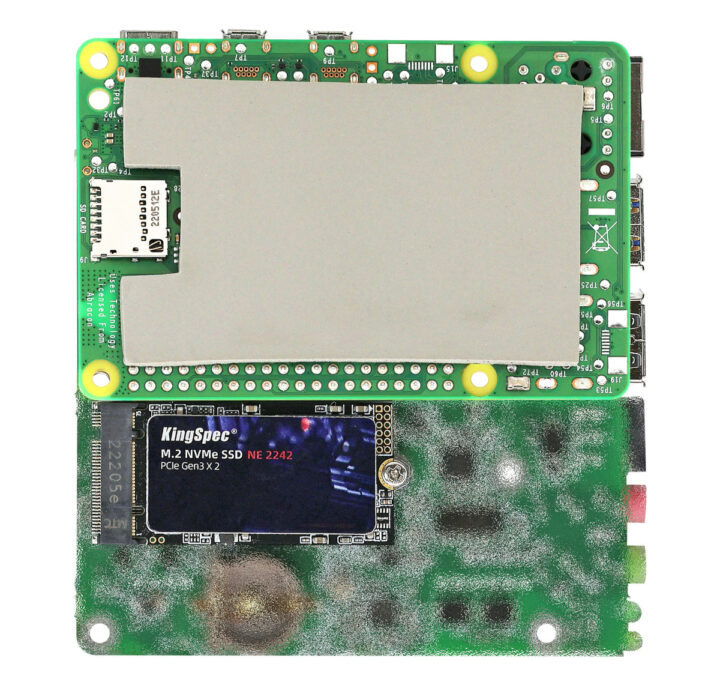 Cooling is further achieved with a heatsink on the top of the Raspberry Pi 5 SBC and a heat spreader on the bottom of the device with which the thermal pad above is in contact. This design would also allow for a thermal pad on the SSD.
Cooling is further achieved with a heatsink on the top of the Raspberry Pi 5 SBC and a heat spreader on the bottom of the device with which the thermal pad above is in contact. This design would also allow for a thermal pad on the SSD.
EDATEC will start shipping the ED-IPC3020 industrial computer in January, but the company is already taking pre-orders for samples on Aliexpress for $165 to $243 depending on the amount of RAM (4GB vs 8GB) and whether a microSD card or a 128GB/256GB SSD is provided.
Further information may also be found on the product page.

Jean-Luc started CNX Software in 2010 as a part-time endeavor, before quitting his job as a software engineering manager, and starting to write daily news, and reviews full time later in 2011.
Support CNX Software! Donate via cryptocurrencies, become a Patron on Patreon, or purchase goods on Amazon or Aliexpress


